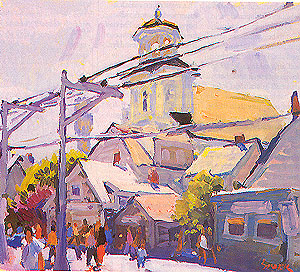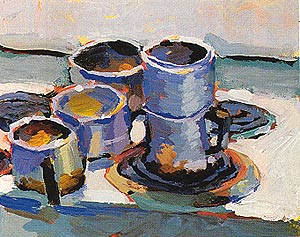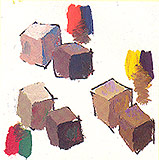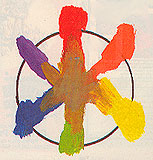
![]()
Articles
|
The Surprising Color of Gray
By Charles Sovek The Artist's Magazine - August, 1999
When Claude Monet splashed pink, orange and purple into the shadows of his somber figures in Luncheon in the Grass in 1866, he changed the course of art history. Before Impressionism, any bravura display of color in areas like this was frowned upon. Grays were gray. And little wonder, because palettes were usually made up of lackluster earth tones, a single vermilion red, ultra-marine blue and lots of black and white. But, happily, the development of brighter colors helped to revolutionize the painting process, and the adventurous young Impressionists learned to imbue even the dreariest subject with a fresh glow of color. Painters today are still inspired by those innovations, and we can use them to make our gray tones as lively as any other part of the painting.
The first prerequisite for painting colorful grays is to determine the source, direction and temperature of the light shining on your subject. You’ll get the best results from a single source because more than one tends to confuse the viewer and disrupt the unity of the illumination. Regarding temperature, warm light, such as that from a table lamp, has a yellowish glow, while cool natural light is bluish. I’t’s also helpful to remember to interpret the glare and dazzle of light – especially sunlight – because the limited colors of your palette will appear puny if you try to copy the light exactly. Painting a picture, including the gray areas, can then be reduced to colorfully contrasting passages of lights and darks. For example, in Provincetown Skyline, above, the three street-level building are each gray compared to the tall church, but the grays are colorful. Each has a decided contrast of light and shadow, and each employs the impressionist theory of using cool, bluish shadows to play off the warm sunfilled grays of the lights. Having determined the light and shadow arrangements in your painting, try incorporating some reflected light into the process. Observe the reflected orange glow in the shadows of the top two tiers of the church in Provincetown Skyline and notice also how the blue of the base shadow set up a pleasing glow of vibration against the overpainted hue of complementary orange. But remember that when complements are mixed together too thoroughly they can create a lifeless gray – the trick when mixing components is to stir the paint loosely enough to leave the original colors peeping through.
Another tip in understanding gray is to know that a tint is light and a shade is dark. For example, the burners of the stove in Coffee Pots, above, are made up mostly of shades of gray mixed from combinations of red, blue and just a little white. The bodies of the pots, by contrast, are essentially tints, or mixes created by combining generous amounts of white with various colors. You may worry that this is too much to think about when all you want to do is paint a gray, but with practice these considerations become internalized, and they make a big difference in your results. We all fall into habits, however, so be careful not to blanket every gray you paint with the same formula of colors. Instead, go gentle with your intensity in a quiet, misty street scene, then slam home the brightest of a sunny market or a beach. Once mastered, the ability to inject color into your grays will personalize your paintings and stamp them with a mark that’s uniquely your own.
|
||||||||||
|
Home | Gallery | Workshops | Lessons from the Easel | Speaking of Art | Biography | Feedback Copyright © 2016 - All Rights Reserved - Charles Sovek |
||||||||||



